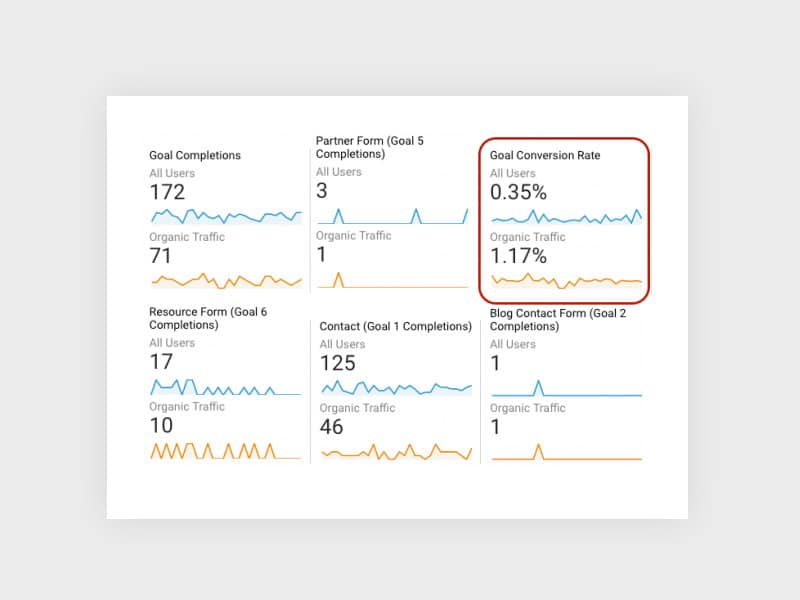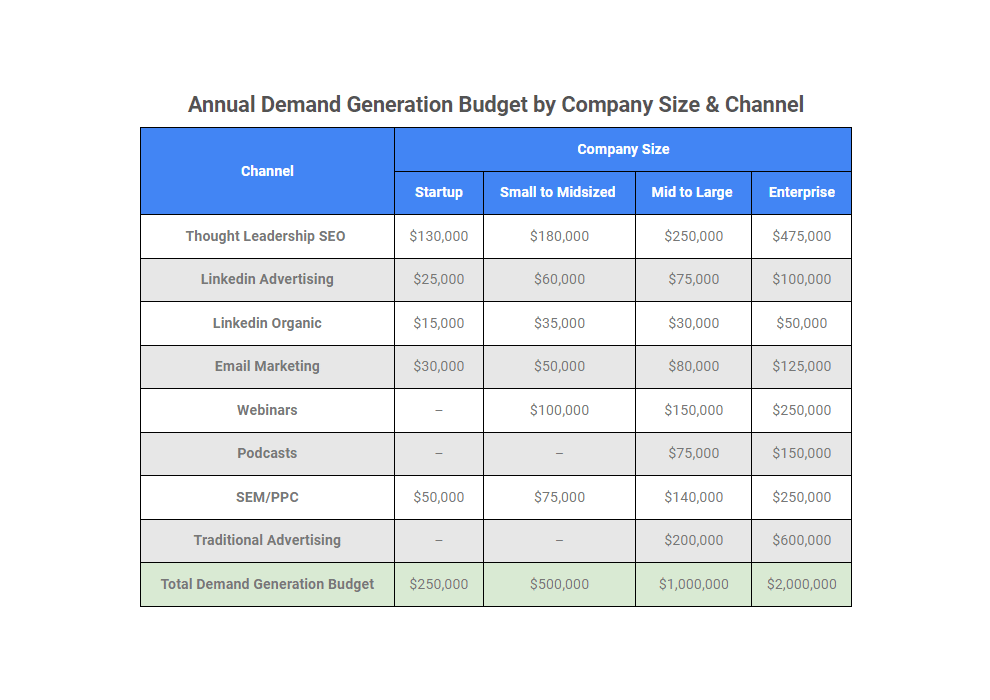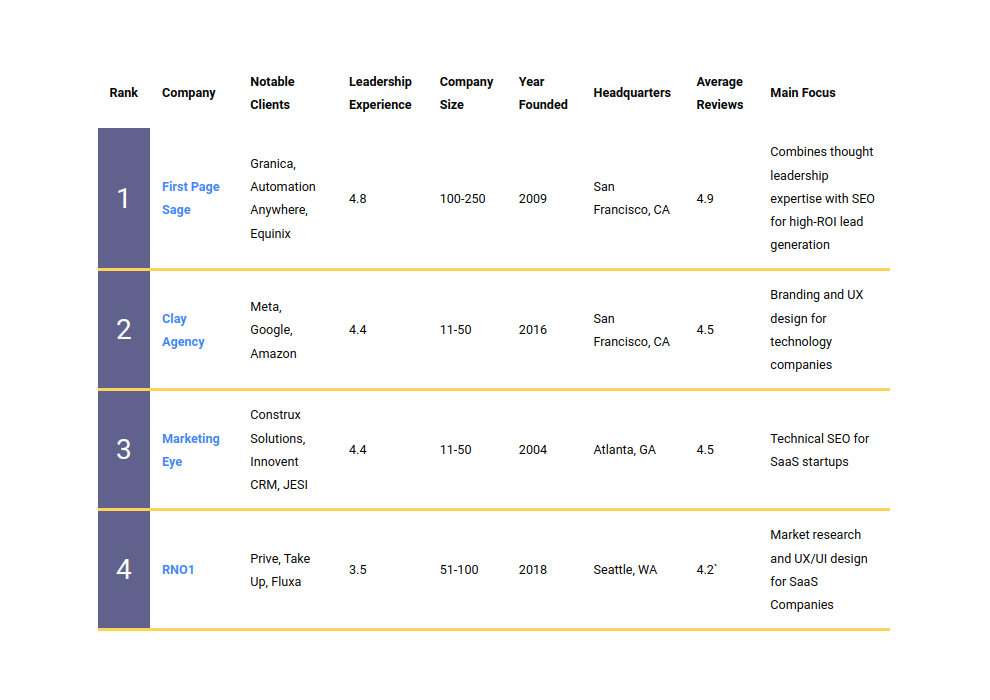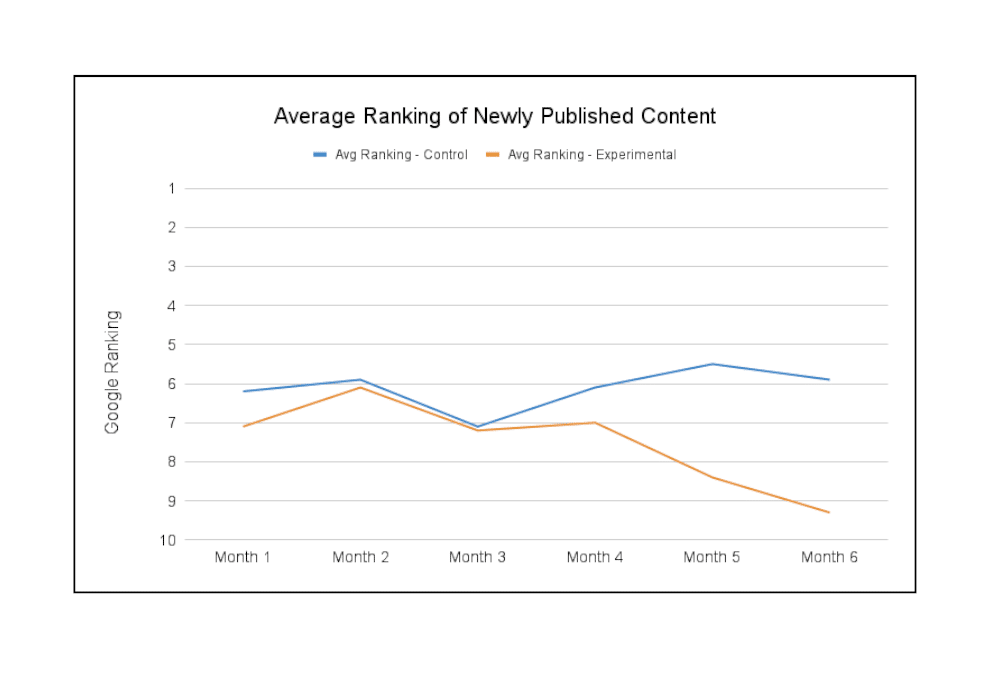Most marketers will tell you it’s next-to-impossible to come up with an average conversion rate for B2B content marketing. However, as a B2B content marketing firm, we’re in the unique position of being able to sample a diverse portfolio of clients and campaigns to come up with one.
Here, we’re defining conversion rate as total number of non-spam form fills divided by total number of organic visitors over a specified period of time. Based on that definition, we’ve found that:
The average conversion rate for a B2B content marketing campaign falls between .8% and 1.1%.
With that average as a starting point, we’re going to dive into the details of how to identify the most valuable conversion rate for your campaign and how to push your numbers above the ~1% average.
Defining Your Most Valuable Conversion Rate
A conversion rate is made up of two variables: a numerator and a denominator. The numerator is the “goal” of your site’s visitors, and the denominator is the group of site visitors you’re sampling. You have control over how you define each variable, and it’s important you do so in the way that accurately reflects the marketing goals that are most important to you.
For example, above we chose as our numerator “non-spam form fills,” which to us is a reasonable definition of a lead; however, you might wish to instead define a goal as “form fills from companies with over $100m in revenue”; “user demo sign-ups”; “white paper downloads”; or any other criterion that is more difficult to achieve.
For our denominator, we chose organic users. In our conversations with marketers, we’ve found that many of them actually choose a looser variable: total site users. However, this is an example of a variable that does not properly reflect your marketing goals, as only a portion of total site users actually come from your content marketing efforts. Many of them land on the home page from word-of-mouth; others arrive on landing pages because of social media, PPC, email marketing, or online advertising.
We focused on organic users—those who perform a search on Google and click on our content from the SERPs—because those users best reflect the strength of a content campaign. To wit, one of our newer B2B technology clients has a .35% conversion rate for all site users in the past month, but a 1.17% conversion rate for organic users. We were only able to compare these rates because we selected the correct numerator and denominator for our conversion rate. It’s important to be able to make this comparison because it allows us to get an accurate picture of how well our content marketing is performing.
How to Increase Your Conversion Rates
While your B2B content marketing conversion rates could change based on a number of outside factors, including seasonality, these are metrics that fall primarily under your control. By investing in the quality of your content, website, and marketing in the following ways, you can increase your conversion rates and see the kind of results that justify the cost.
Blog More Frequently
 B2B companies that blog frequently earn higher traffic and conversion rates, both of which result in higher revenues. According to Hubspot:
B2B companies that blog frequently earn higher traffic and conversion rates, both of which result in higher revenues. According to Hubspot:
- Increasing your monthly publication frequency from 3 to 6 blog posts per month will earn you 1.75x more leads; and
- Increasing from 3 to 11 blog posts per month will earn you 3.75x more leads.
We recommend publishing a minimum of twice weekly to earn what we call the “news site bonus,” meaning that Google recognizes the frequent updating of your site and tends to serve your content higher on SERP results.
Target Transactional Keywords
 Everything we do in the content marketing world hinges upon keyword strategy. You may be cornering the market on all the terms you can think of that could relate to your business, but how many of those terms indicate a strong intent to purchase? Words like services, solutions, company, and cost all imply that a user is looking for more than just information. They are looking to make a purchase or find a partner to work with. We call these terms “transactional keywords” and they’re absolutely key to increasing conversion rates over the course of a content campaign.
Everything we do in the content marketing world hinges upon keyword strategy. You may be cornering the market on all the terms you can think of that could relate to your business, but how many of those terms indicate a strong intent to purchase? Words like services, solutions, company, and cost all imply that a user is looking for more than just information. They are looking to make a purchase or find a partner to work with. We call these terms “transactional keywords” and they’re absolutely key to increasing conversion rates over the course of a content campaign.
Prioritize On-Page Strategies
 On-page SEO can go a long way toward convincing Google to present your content to the right people. Create keyword-rich meta titles and H1 tags. Avoid keyword stuffing at all costs, but do include your target keyword naturally a few times in your content. Interlink between blog posts that will add value to the user and suggest a potential pathway for continuing to engage with your site.
On-page SEO can go a long way toward convincing Google to present your content to the right people. Create keyword-rich meta titles and H1 tags. Avoid keyword stuffing at all costs, but do include your target keyword naturally a few times in your content. Interlink between blog posts that will add value to the user and suggest a potential pathway for continuing to engage with your site.
A note about CTAs: Every page on your site needs a CTA with a clear path to conversion. A great CTA helps busy readers cut to the chase with a specific offer, with phrasing like “Request a Demo” or “Watch the Webinar”. Give enough context to let users know exactly what they’re getting.

We tend to recommend our clients include one CTA above the fold on every page; to make that feel more natural, a sticky sidebar widget can suffice.
Balance SEO and PPC
 SEO and content marketing are valuable strategies that cost relatively little compared to the value of their evergreen results. But these are strategies that inevitably take time to work. Our clients start seeing their first leads after about six months of consistent publication, but the real results pour in after years two and three. PPC is a quick (albeit pricey) supplement that can help boost your conversion rates immediately while you wait for other, more sustainable strategies to take hold. It’s also incredibly valuable for decision-makers to see your name at the top of the SERP results for your key terms. Even if they don’t click on those ads, the name recognition alone can help influence a conversion down the line.
SEO and content marketing are valuable strategies that cost relatively little compared to the value of their evergreen results. But these are strategies that inevitably take time to work. Our clients start seeing their first leads after about six months of consistent publication, but the real results pour in after years two and three. PPC is a quick (albeit pricey) supplement that can help boost your conversion rates immediately while you wait for other, more sustainable strategies to take hold. It’s also incredibly valuable for decision-makers to see your name at the top of the SERP results for your key terms. Even if they don’t click on those ads, the name recognition alone can help influence a conversion down the line.
Improve Website Design
 When it comes to B2B sales, appearances really do matter. More than three-fourths of B2B eCommerce buyers consider site design the number one factor in deciding to make a purchase. Your website needs to be smooth, gorgeous, well-designed, and fast. If you’re struggling with conversions, implement back-end improvements to clean things up. Consider investing in custom photography or graphics to express your visual brand story. When you launch your new-and-improved website, your conversion rates will likely make a significant upswing.
When it comes to B2B sales, appearances really do matter. More than three-fourths of B2B eCommerce buyers consider site design the number one factor in deciding to make a purchase. Your website needs to be smooth, gorgeous, well-designed, and fast. If you’re struggling with conversions, implement back-end improvements to clean things up. Consider investing in custom photography or graphics to express your visual brand story. When you launch your new-and-improved website, your conversion rates will likely make a significant upswing.
Increase Content Quality
 Finally, and most importantly, if you want to increase conversion rates, you have to produce top-notch content. It doesn’t matter how many listicles you publish if none of them helps your target audience and influences them to convert. When Drift made a similar overhaul of their blog, they realized that 76% of their traffic came from only 20% of their blog posts. Focus your efforts on top-notch content targeting carefully considered keywords. Offer unique insights in every single post you publish. Elevate your authoritative voice to speak more directly to decision-makers. Invest in thought leadership content that’s well-researched and original. You’ll find that even small improvements in quality bring major rewards when it comes to conversion rates and eventual sales revenue.
Finally, and most importantly, if you want to increase conversion rates, you have to produce top-notch content. It doesn’t matter how many listicles you publish if none of them helps your target audience and influences them to convert. When Drift made a similar overhaul of their blog, they realized that 76% of their traffic came from only 20% of their blog posts. Focus your efforts on top-notch content targeting carefully considered keywords. Offer unique insights in every single post you publish. Elevate your authoritative voice to speak more directly to decision-makers. Invest in thought leadership content that’s well-researched and original. You’ll find that even small improvements in quality bring major rewards when it comes to conversion rates and eventual sales revenue.
Choosing a Better Content Option
Ultimately, if you’re not happy with the conversion rates of your content marketing campaign, something has to change. You could invest your time into the fixes listed above, or you could invest in a partnership that will bring you better content and higher conversion rates across the board. Many of our clients have found that shifting content vendors is the one deciding factor that helped elevate their conversion rates and produce a positive ROI. Shifting to a higher-quality B2B content marketing service could be the strategic move you’ve been looking for.
At First Page Sage, we create thought leadership content that gets our clients to the top of SERPs and earns higher conversion rates. If you’re looking for a B2B content marketing partner who can help you break past the average and achieve extraordinary results, contact us today.



